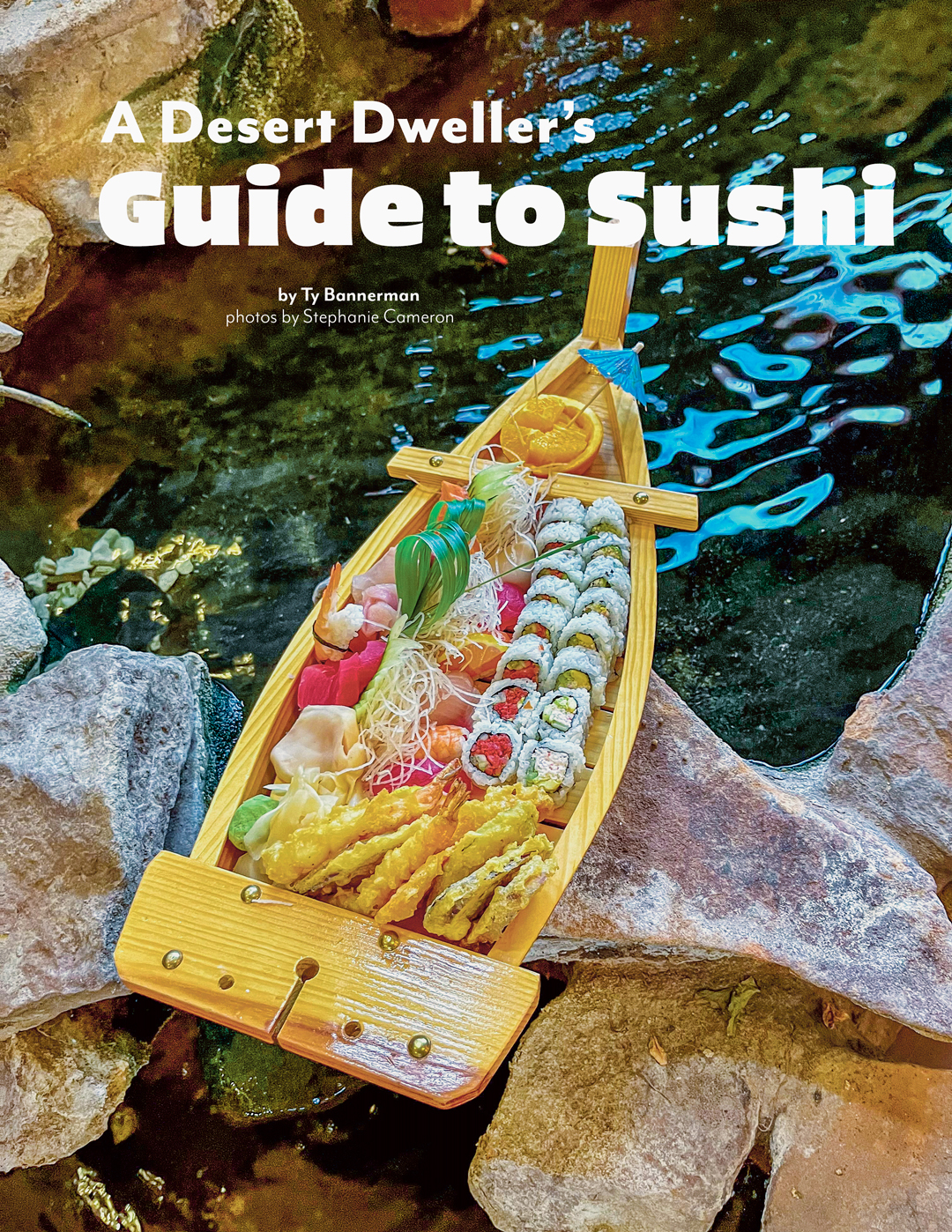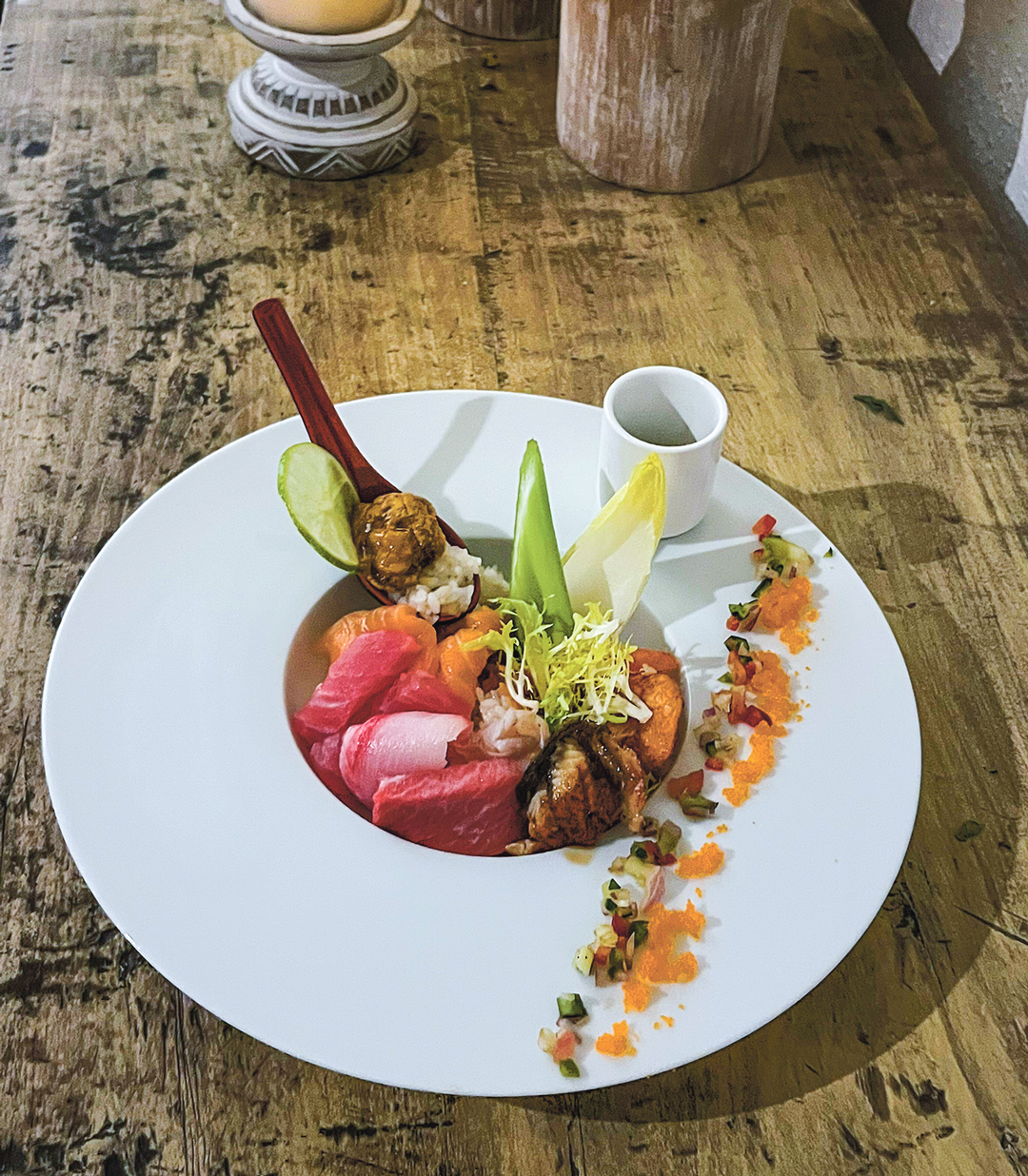
Koi pond and Love Boat for Two at Naka Sushi.
When Albuquerque restaurant Taro’s Gardens started serving sushi in 1969 (a mere five years after the first true American sushi bar opened in Los Angeles), many of the city’s residents may have been skeptical about eating raw fish eight hundred miles from the nearest coast. Considering that neither the transportation networks nor the freezing technology of 1969 was up to our current standard, they were probably right to be cautious.
But what about today? A half century later, New Mexico is no closer to the ocean, but does that mean our nigiri is still inherently suspect?
Good news: Although the world of 2022 is still a factory of fears, anxiety over the safety of New Mexican sushi should not be keeping you awake at night. One of the unsung wonders of the modern world is flash freezing, and yes, despite what you may have assumed, all uncooked sushi in the United States is legally required to be frozen before it arrives on your plate. Because raw fish is sketchy.
Things live in it. As an example, the anisakid nematode is a nasty little worm that happily transfers its feeding ground from the belly of a cod to the belly of a human without the slightest discomfort to itself (plenty of discomfort for you, however). Perhaps the gamblers out there may be willing to risk a parasitic infection for a gorgeous slice of tuna pulled straight from the sea, but the US government would prefer not to deal with any extra disease outbreaks right now and insists that any sushi restaurant that wants to stay in business must employ the wonders of the flash freeze.
Here’s how it works: Within a few hours of a fish being caught, the flash-freezing technicians dunk it into a broth of liquid nitrogen or freezing ethanol. Within minutes, the fish reaches -70 degrees Fahrenheit, eliminating any potential parasites or bacteria. And no need to worry about freezer burn either: the rapidity of the technique means that the fish will stay preserved without the large ice crystals that form from conventional freezing, which damage tissues and flavor.
And then it’s off to the highways and flight paths of the US shipping network, to be received by a distributor and then the local sushi chef of your preference, who will slice it and roll it into the most beautiful makizushi you’ve ever seen.
So belly up to the sushi bar, my friends, and don°Øt worry about how far your fish had to fly to reach your plate. All that really matters is how quickly it was flash frozen after being caught.
Now that your fears are allayed, where should you eat? Sticking to the urban centers of central and northern New Mexico, you’ll find that the days of one or two sushi options in Albuquerque and Santa Fe are long gone. In fact, you may well find yourself bewildered by the options. Here, then, is a quick guide to a variety of sushi experiences, from joints that stay true to sushi°Øs street-food roots to divine dining presided over by master chefs.

Naka Sushi.
ALBUQUERQUE
Shogun Sushi
3310 Central SE
Maybe I’m just a sucker for gimmicks, but I’ve been bringing my kids here to have their sushi selections delivered by boat—boats sailing on an ever-running stream!—since they were born. These cheerful vessels bear the slightly smoky-sweet freshwater eel nigiri, clean and pink fresh salmon, and even the ABQ Roll with its tempura jalapeños and hillocks of emerald flying fish eggs. It’s not a Nob Hill institution for nothing.
Fareast Fuzion
5901 Central NE, #1703
Crash kerplunk in the middle of Albuquerque’s International District, this restaurant offers up a fine variety of foods from a number of Asian epicenters. But that’s not why you’re here, is it? The sushi is affordable and could go toe to toe with the offerings at more expensive restaurants, no problem. In fact, two to three diners can happily feast on the Small Happy Boat, which offers rainbow-vibrant nigiri (ours came with tuna, shrimp, and salmon, each offering just the slightest hint of the faraway salty sea), delicately sliced sashimi, and a thick California maki roll—and did I mention it comes in a boat? I love boats.
Naka Sushi
1035 Juan Tabo NE
A comfortable, cozy atmosphere greets the sushi-hungry here. From the koi pond to the tall-backed booths, you can’t ask for a warmer environment. Like Shogun and Fareast Fuzion, they offer a boat—yes, a BOAT!—full of chef’s choice delicacies. Ours featured a crew of golden, lightly crunchy shrimp tempura watching over a deck full of nigiri. If given the choice, ask for the hamachi, buttery and rich on its bed of sticky, but not clumpy, rice.

Sushi course in Chef Hattori’s omakase.

Makizushi (a selection of rolls from the day’s offerings) at El Nido -Su.
SANTA FE
Kohnami
313 S Guadalupe
The localized roll has been a standard offering of Americanized sushi restaurants ever since Californians stuck avocados into their maki, and Kohnami has a variety of whimsical examples to offer. From the fiery frizzle of a Kick In the Nose Roll (tuna, salmon, and yellowtail accompanied by the punch of Japanese mustard) to the understated charms of the Geisha Roll (three kinds of fish served with bright red smelt on top), your taste buds will stay intrigued over several visits.
El Nido -Su
1577 Bishops Lodge
Make your reservations at this sushi speakeasy in Tesuque and you’ll be ushered in through a classic New Mexico adobe and into the rarified atmosphere of -Su, presided over by Chef Masayuki Hattori. For an exceptional experience, dive right into the omakase, or chef’s choice, and indulge in a tour of Hattori’s culinary whims. There are also plates of nigiri, each resting on a bed of lightly vinegared rice, or makizushi—no less masterfully made. A unique touch is the freshly grated wasabi, which offers a sweet prelude to the more familiar heat we usually get from wasabi paste. ,

Ty Bannerman
Ty Bannerman has been writing about New Mexico for over a decade. He is the author of the history book Forgotten Albuquerque and his work has appeared in New Mexico Magazine, Atlas Obscura, Eater, and the American Literary Review. He co-hosts the podcast City on the Edge, which tells stories from New Mexico’s past.


